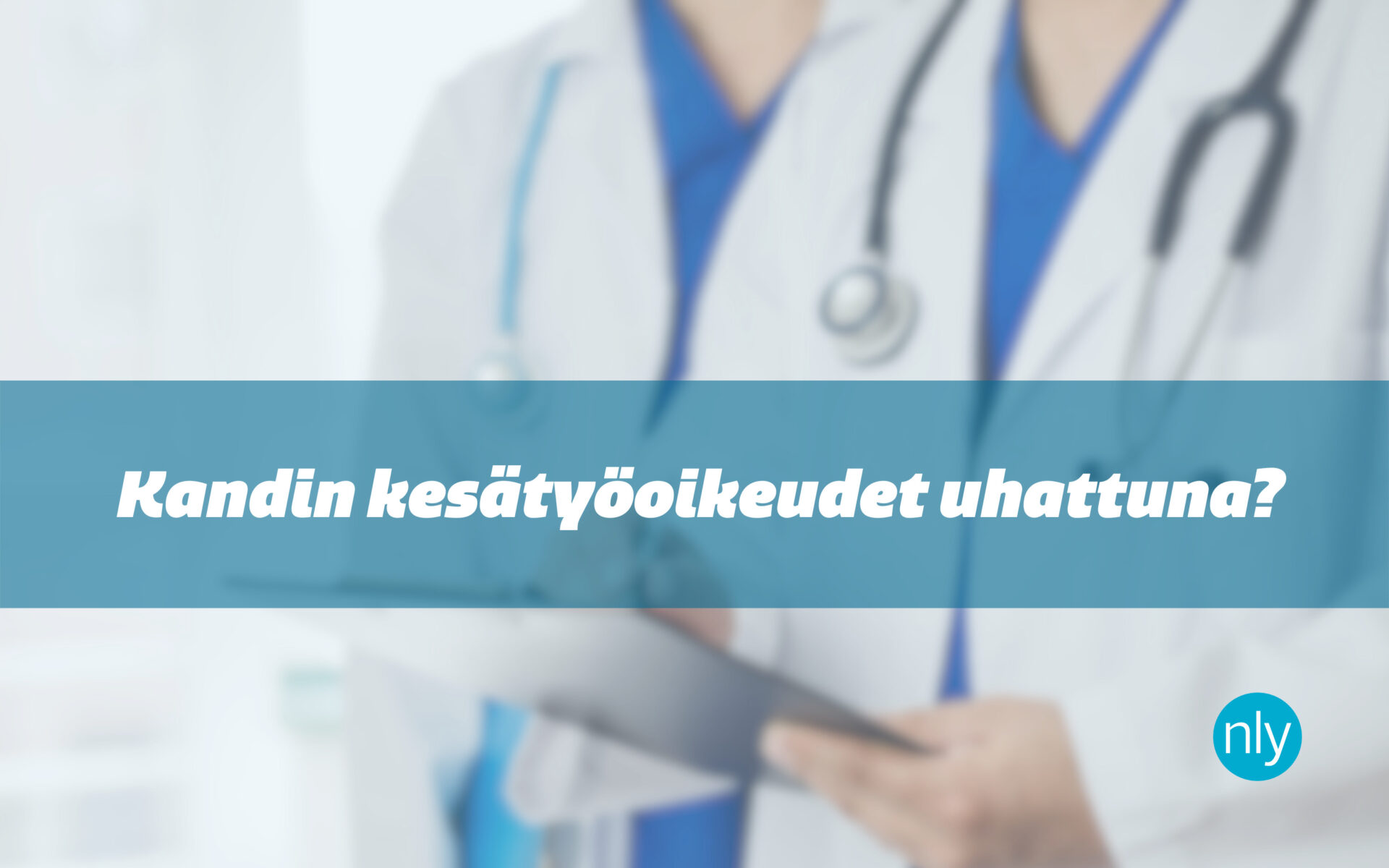Varoitus! Tämä artikkeli on englanniksi!
I thought about what language to use for my articles and social media campaigns quite some time and in the end I decided to use English. Although I’m working in Finnish, reading the newspaper in Finnish, watching Sorjonen in Finnish and although I’m even in the active process of losing the ability to talk about medical stuff in German (which is my mother tongue), still English is favorable if I want to bring my own style, personality or wit into a text. And, of course, there might be new foreign colleagues and international students out there who are also more comfortable reading a text in English. So that’s that.
Let’s start with a number and some wordings. According to a survey done by Lääkäriliitto in 2010 about 6% of the doctors working in Finland are foreign. Foreign meaning that they do not hold the Finnish citizenship. All the doctors born in other countries, but already holding the citizenship are not included in that number. Also not included are doctors with another citizenship, but for whom – based on their name, mother tongue and/or place of studying – it stands to reason that they are more Finnish than something else. Complicated. Who are those people we’re talking about? Did that number grow in the last 10 years? Due to Erasmus and mobility it should’ve, but we don’t know. New numbers would be needed (dropping a broad hint to Lääkäriliitto here).
So, let’s just estimate we’re talking about 8-10% of the total number of doctors being “foreign” by some kind of definition. Where do they come from? What do they need to help with integration? How do they learn the language? How do they cope? What problems do they have? Those are just some questions I’d like to try to answer from my very own perspective in the upcoming months. Because I’m part of “they”. I came to Finland in summer 2016 as an Erasmus student. Three and a half years later I’m sitting in TAYS/Acuta writing a blog article for the NLY (which, btw, I didn’t even know existed until about a year ago). It’s a calm morning, no patients yet on my list…
After living the Erasmus-dream for a bit more than a year, I decided to stay. Well, it was not that much of an active decision as one might think. It just happened. But with this plan came the hard facts: what do I actually need to do to get my license? Well, lucky me, I’m an EU citizen who studied in the EU! Meaning: fill out the application form, give us a copy of your passport and your original medical qualification document, show us some document stating that you’re licensed to work as a doctor in another EU country and there you go! But, wait: you also must submit a certificate of your language skills. Finnish, of course. Well, that’s pretty understandable. Can’t work without language. What kind of certificate is suitable? The YKI (Yleinen Kielitutkinto) test, medium level.
So I went to TE-toimisto and asked about a suitable language course for me, a medical doctor. First I was told: “Well, it will take us about one-and-a-half years to get you on the market as a doctor.” Excuse me? 18 months? What am I going to do these 18 months? “Well, the language course itself takes about a year and then you’ll have to wait about 2 months for the YKI results and after that about 3 months for your Valvira license.” Ok…Jesus. Can’t I just skip part of that language course and do it quicker? “You can try to skip the first half of it, go to this institute and do the language level test, let’s see where we are.” So I took the business card. Turned out: after one year of living here I was enough to skip the A1-A2 level course. Back to TE-toimisto. “Great, well done. You’ll get one of the next available places in a language course. Some already started last week, but there’s always a drop-out.”
So…it won’t be a special course for people working in social or health care jobs? “No, we do not have that. It is the normal language and immigration course. For everybody who wants to do the YKI medium level.”
Is there any course I could do on the side? For doctors or nurses? “Unfortunately not, probably there would be in Helsinki. There’s a summer course sometimes held at Tampere University, but I don’t know if we’ll pay for this.” Ok…”And if you want the money from TE-toimisto, then you’ll have to go to the course we provide, the one with the next free spot.” Sure, no problem. This resulted in me sitting for six months in a full-time language course that was not only kind of too slow, but also not at all directed towards health care workers. But in the end, I passed the YKI, got my license and started working. Great, huh? No. Because the YKI does not prepare you at all for the vocabulary and phrases you’ll need as a doctor. It is just not practical. The preparation for it gives you enough knowledge on grammar and basic vocabulary to survive in a normal office job, but starting to work as a doctor without a glimpse of how a doctor writes in Finnish is just not funny.
Also not funny: you don’t know that Terveysportti exists. Again: you do not know. There’s no way to know such things until somebody tells you. You also don’t know about Duodecim, Kollega, kardio.fi, the normality of consulting specialists working at the University Clinic via phone and so on. That’s a huge disadvantage if you have to take care of 25 elderly patients alone for the first time in your life. All your background suddenly seems to be a disadvantage. Honestly, if people hear your accent, hear you fighting for the right words in the right cases…those looks…you start thinking: do they feel like my professional knowledge is as low as my knowledge of this damn hard but beautiful language? Hope not… Almost two years after I started working as a doctor in Finland I do not only survive, I do really well. Patients tell me that they feel safe in my care, that they feel heard and respected. And sometimes they leave Acuta with a heavily accented “Auf Wiedersehen!” and a smile.
Back to the question: What does a foreign doctor need? Medical language skills, first of all. Understandably it is not possible to implement courses with physical attendance all over Finland. But, living in the 21st century, we can think further. At the moment there is a 5-part-online course available on Duodecim, but…well…let’s politely say: it focuses too much on grammar. We could improve it, sure. We should. But we could also implement a brand new one via app. Where are all those young innovative start-up people? There’s a job waiting for you, please contact me for a medical finnish course that actually changes something for hundreds of foreign doctors in Finland and their thousands of patients. We could also fill the enormous gap of the missing “Finnish for foreign doctors” book. Actually, there is one in development right now. What else do these foreign colleagues need? Social contacts. We could, for example, implement a buddy system in health care centers and hospitals. Or via social media?
Foreign doctors also need a voice. Somebody whose experience on a personal level leads to the intrinsic motivation to talk openly about the issues of this small group of colleagues, to criticize unfortunate chains of thought or decisions. Our language skills, for example, are often in the focus of discussion. There are rumors about colleagues who want to raise the language level needed for receiving your license to C1 (European language level 5 out of 6). C1 is, by definition, almost native speaker level in everyday life and work-related situations, presentations, reports, instructions and explanations in detail. Now, consider your English-level, please. Generally speaking it will be something between B1 – oh yes, I have heard some interesting conversations between colleagues and english speaking patients – and C1 – I have also heard perfect english from my colleagues. There are worlds between those levels and at every level in between patient care is possible, safe and productive. And now let’s step back and listen to the TE-toimisto woman again: “It will take you about one-and-a-half years to get you on the market.” Because of the B1 language test! Now just think about how long it might take if you would have to reach C1 level.
That’s how you create an unnecessary barrier while at the same you don’t ensure necessarily better communication between Finnish patients and foreign doctors. It’s the typical easy solution that looks good on paper, but doesn’t solve anything for anybody on a practical level. The solutions I suggested above actually could lead to an improvement for everyday life in Finnish hospitals.
So there you have some things I want to work on as soon as possible. But international affairs do not only concern foreign doctors in Finland, international work also includes Finnish doctors who have studied abroad. Other hot topics are european-wide studies on the well-being of young doctors or the actual implementation of the EU working time directive as well as human rights and health care for migrating people or the handling of worldwide health care issues. You see, there’s a lot to cover – stay tuned.
Sarah Schober
NLY hallitus; Kansainväliset asiat




